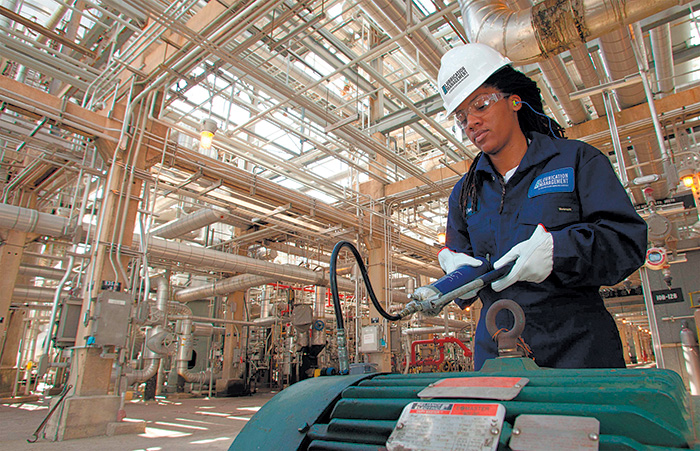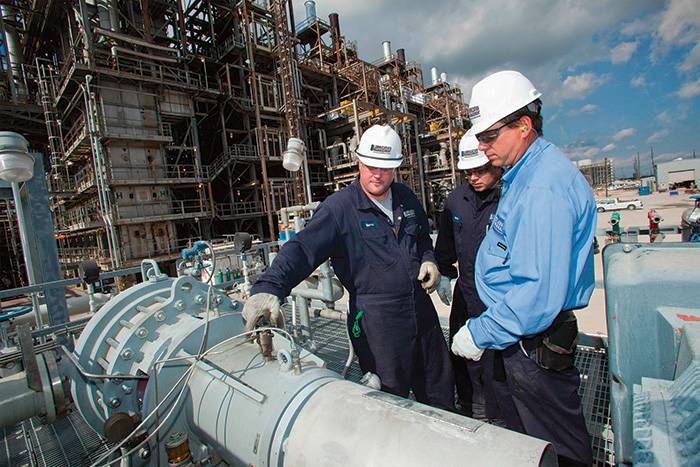Pumps & Systems, February 2013
Rotating machinery requires regular lubrication maintenance to operate at peak performance. Downtime due to poor lubrication practices is a prescription for lost production and, worse, lost profits.
From the 1950s until the 1970s, many companies had employees that continuously monitored equipment. Automated monitoring systems became popular in the 1970s. Through the 1980s, they helped to simplify the process, but the hands-on, watchful-eyes approach was lost. Restructuring was introduced in the ‘80s and ‘90s. Trained company personnel became untrained contract personnel. A lot of skills were lost and equipment reliability slipped as production became the focal point.
The last 10 to 15 years have generated improvements in optimizing equipment reliability because of employee training and services provided by specialized lubrication support companies. Root cause analysis of equipment failures has put the spotlight on lubrication as one of the most common causes of equipment/bearing failure, with particle contamination being the primary culprit. Trained personnel—who are employed by support companies, such as training organizations, equipment/product suppliers, analysis laboratories and specialized service companies—perform root cause assessments that include oil analysis and condition monitoring.
The Importance
A quality lubrication program is essential to ensure the reliability of operating equipment and to maintain its performance. The equipment requiring lubrication may be compressors, pillow block bearings, gear boxes or process pumps and motors. Each piece of equipment has specific lubrication requirements. These include:
- Lubricant viscosity
- Type of lubricant
- Recommended re-lubrication or lubricant sampling schedule
This may require an extensive inventory of lubricants and a detailed maintenance schedule. Along with the equipment’s lubrication requirements, the equipment also has requirements for:
- Flushing
- Varnish removal
- Reservoir maintenance
- General system upkeep—such as circulating oil, grease and oil mist
Best-of-class facilities have implemented programs to optimize their lubrication process, which include a checklist of all equipment and its lubrication requirements. They comprehensively train key maintenance personnel or outsource these tasks to a company or companies that provide the needed services. Several companies are often used to implement the different tasks—such as performing the lubrication sampling and analysis, flushing, oil remediation and installation of centralized lubrication systems. Some companies perform all these tasks. Working with outside vendors can be a fast track to getting the services performed and improving equipment reliability.

| The three steps to reliable equipment performance and increased uptime at refineries and petrochemical operations are monitoring, maintenance and optimization. |
Monitoring Is the Key
Monitoring the overall lubrication process is essential to its performance and the end result. If a process is not monitored, no one will know if it is a success or failure. Monitoring programs require detailed audits of the facility’s lubrication practices and systems. These will show the areas that offer the greatest opportunity for improvement. As the audits are performed and corrective action taken, the lubrication program becomes a reality, and the improvement process is started. Monitoring services should begin with an on-site inspection of the facility’s lubrication systems and practices. These should include testing the lubricants upon arrival, reviewing their storage and handling on site, examining the distribution to the rotating equipment, lubrication sampling while in use and consistent tracking of those samples. They should also examine contamination control to mitigate potential sources of contamination—including air, water and particulate—and cross contamination, which can alter viscosities and cause equipment damage.
Monitoring should also go beyond the tangibles. If the facility has a set of lubrication guidelines that includes goals and metrics, those factors should consistently be reviewed and updated as equipment and production methods change. If such guidelines do not exist, a monitoring program can help establish them. Monitoring should also examine the facility’s employee training procedures for lubrication practices—and this should include a frank review of the facility’s safety procedures. Ultimately, the goal of the monitoring and assessment process is to deliver a lubrication best-practices approach that identifies areas for improvement, provides specific recommendations on how to achieve those improvements and calculates the expected return on investment.
Each facility is different, so each facility’s “road map” that results from monitoring will be different, too. One facility may see immediate gains from a change in lubrication storage, where another may see key gains from an enhanced lubrication training program. Implementing every recommendation immediately may not be practical. These changes may need to be made over time.
Finally, no facility manager should regard the lubrication assessment as a one-time event. The facility’s needs will change periodically. As programs are refined, new equipment is brought on board and older equipment is retired, annual lubrication assessments should be performed.
Maintaining the System
As new lubrication practices are established, the facility’s maintenance plan should include regular on-site inspections, and cleaning and lubrication purification should be developed and implemented. Working with an outside support company provides a second set of eyes and ears and ensures that the lubrication system checklist delivered through the monitoring phase is followed appropriately.
Equipment upgrades may be a part of this phase. An investment in new lubrication equipment—such as oil mist lubrication/oil mist preservation—may be an important factor in extending lubricant life and protecting system integrity. Plant-wide oil mist application is proven to lower maintenance costs.
It also lowers operating manpower costs, reduces overall lubricant consumption, saves energy and reduces the potential for fire incidents. The support company may also offer as-needed services—such as high-velocity oil flushing, varnish removal and change-out services—depending on site-specific conditions. Some offer on-site portable equipment to perform these services or regionally-based large capacity capabilities for fast purification turnaround.

| Lubrication specialists can help reduce potential equipment failure due to poor lubricant quality. |
System Optimization
Continuous improvement can be achieved through a commitment to annual monitoring, adjusting the lubrication program accordingly and an enhanced maintenance program. To fully optimize the lubrication process, a facility should commit itself to a best-practices program that includes sustainability and establishing a system of documentation to show continuous improvement and overall cost savings.
Sustainability includes a commitment to operating in a “green,” safe manner, which focuses on lubricant storage, handling, disposal and recycling. It also includes rationalizing the lubricants used in the facility to ensure that lubricant inventory meets the actual facility needs.
Documentation should show proven overall monetary savings iand savings in reduced downtime and improved facility safety records.
Flexibility
Flexibility is an important word to remember when working with a specialized lubrication support company, particularly in the monitoring/assessment phase. Facilities must work with lubrication experts who understand a facility’s unique needs and provide a thorough examination before offering solutions. This can be a painstaking process but worth the time and effort. While an off-the-shelf solution may be sufficient to address an obvious need, it may prove to be only a short-term solution that provides little benefit in the long run.
Facility managers should remain flexible and open to new ideas and suggestions as the lubrication optimization process begins. The time taken to assess and monitor is a small investment compared to the millions at stake in terms of keeping a plant’s rotating equipment operating and profitable. P&S

